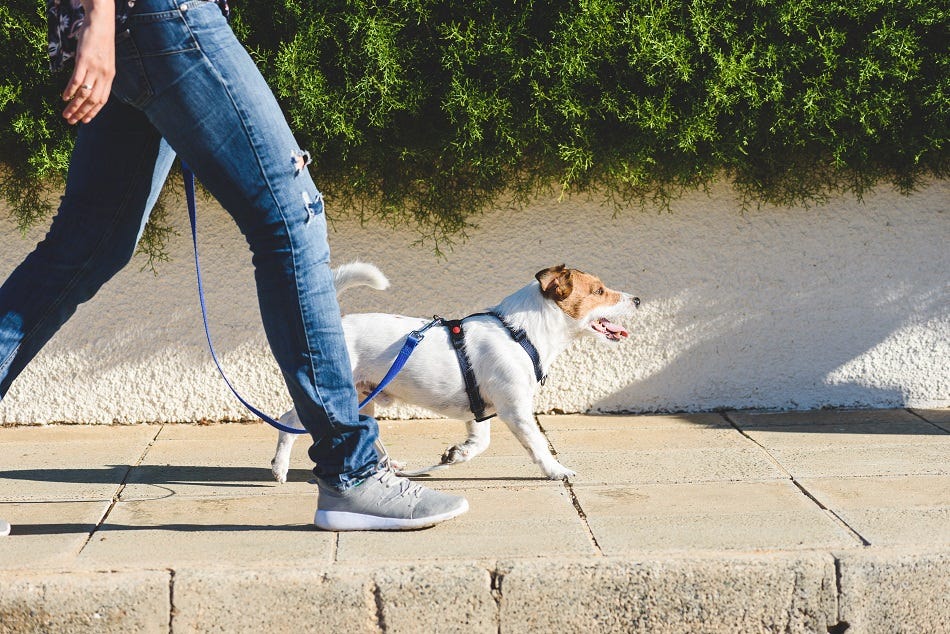A new puppy comes with plenty of benefits. Along with that unconditional love only a dog can provide, they also encourage us to get outside and enjoy the fresh air. Walk times are a puppy favourite! Getting them outside, pounding paws on pavement can be a great training tool and can also help burn a lot of energy.
While they might seem like an endless ball of energy, there are very real dangers that come with over-exercising and pushing your pup too far. So, before you click on their brand new leash and get your puppy walking, take a minute to find out everything you need to know. We’ll take you through common questions like, ‘When can I walk my puppy?’ and also give you some tips on what behaviours to avoid.
When can puppies go for a walk?
As tempting as it can be to take your pup straight out into the big wide world, you need to make sure it’s safe for them. There are plenty of nasty parasites and potentially fatal viruses lurking in parks, popular walking tracks and the local dog park. Your puppy's immune system is still developing, so it's important to keep them safe. Knowing when to start walking a puppy is all down to their vaccinations. At Best Friend Pets, we recommend waiting 10 to 14 days after your puppy's last vaccination booster.
Learn all about your pup's vaccination schedule here, and make sure they’re up-to-date before you take them out.
It can be tricky trying to make sure your pet is socialised and working off all their energy, which is why it’s a good idea to enrol them in puppy school. This way, they can run, play and socialise with other ‘safe’ dogs in a controlled environment.
How often should I walk my puppy?
Learning how often to walk your pup is all down to their breed, size and even personality – every puppy is different. Some breeds may prefer a shorter walk two times a day, while others may enjoy just one big walk. Overall, you should try and aim for one walk a day. This isn’t something you’ll figure out your first time walking a puppy. However, there are a few things you can keep in mind:
- Energy level. It's true that all pups love to play, but higher-energy breeds like a Golden Retriever will probably love long walks.
- Mental stimulation. Breeds like the super-smart Border Collie may need more mental stimulation than other pups. That means more time spent outside exploring.
- Size. Consider how big your dog is now as a puppy and as an adult. The bones and joints of larger breed dogs like Great Danes mature more slowly, which means they shouldn't take long walks, but rather several short ones. Also remember that what feels short for a bigger dog, may feel like a marathon to a tiny pup.
Another fun thing about walking puppies is the different places they get to explore. You might also find that your pup likes to stay out for longer in different environments. They might love spending an hour down the beach, and only prefer a short trip to the dog park.
How far can a puppy walk?
Similar to how often you should walk them, knowing how long to walk a puppy will also vary. As your pup gets older, you might find they can go for longer walks. At first, you might find your pup only likes a half an hour walk. As they get older, you can start to stretch it out longer. Make sure to keep a lookout for signs of over-exercising a puppy, like panting and a slow pace.
Their breed will also impact how long your pup can go for. Small breeds like Corgis and Pugs tend to struggle with long distances because of their little legs. Bigger breeds like German Shepards can cover much longer distances thanks to their long legs.
Another thing to keep in mind is their attitude. Some dogs just don't like to exercise. However, you'll still need to try and force your couch potato out on their daily walk – even if they really don't want to! Other dogs may go mad trying to get out for their outdoor adventure. Take cues from your pup and start to learn what they prefer. Some may love a good play session in the garden, while others like to explore new scents. Learn their exercise style as they grow up so that you can adapt to suit them.
Things to avoid when walking a puppy
The right amount of puppy exercise is an important part of their growth and development, and walking is the easiest way to stimulate them. While you might have a few things you wish your puppy didn’t do during a walk, they may also have their own list of things you do that drive them crazy. To be the best walking partner for your pup, there are a few things you should keep in mind.
- Consider the weather. In summer, dogs can easily overheat and suffer from heat exhaustion. Plus, the pavement can be hot. Not only is it uncomfortable, but it can also lead to serious injury and even burns.
- Pack water. A collapsible bowl or water might not be needed for a quick walk around the block, but if you go for long walks, you should definitely pack hydration for your pup! Plus, walking on warmer days may also call for a thirst-quencher.
- Don't let them get too close to other dogs. While some doggos love to meet new friends – others may not. Walking is a great chance for your dog to meet others, but try and make sure their first meeting is on a leash. This way you can control the interaction.
- Use the right equipment. Harnesses are a great option for walks. Collars can be stylish but can put pressure on the throat and neck. Harnesses are a comfortable alternative and can even make leash training a little easier.
- Pulling them away while they're sniffing. One of the best things for our pups about their daily walks is the chance to explore the world through scent. Hurrying them along can put a real dampener on the whole experience. Plus, sniffing and new scents are a great way to stimulate their minds.
Remember to go at your puppy's pace and observe their needs. Their first walk is an important step to creating a bond and exercise routine that they love. As much as you can benefit from a daily walk – it's also about them! When taking them out, be observant and pay attention to their cues. If they suddenly lie down or stop, it's a sign they've had enough!
FAQS
What age can a puppy go for a walk?
Taking your pup for their first walk is more about their vaccination status than their age. Most doggos won’t be able to go outside for walks until they’re fully vaccinated until around 14 to16 weeks of age. Remember to start small when they’re young and build up to more intense walks!
How can I stop my puppy from pulling on their leash?
There is a range of methods you can try to counteract your pup pulling on their leash. From specific harnesses to reducing the pace and even puppy training. Find a method that works for you and make sure you stick to it.
How do I know if I’m over-exercising my puppy?
There are key signs that your doggo will start to display including fatigue, panting and lagging behind you. If you notice this, give them a minute to catch their breath. However, any signs of drooling, excessive panting or vomiting means you should cut your walk short.
Shop from our great range of collars, leads & harnesses
























